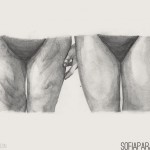Excess skin and fat can cause sagging on the inside of the upper leg. Sometimes it is enough to remove some fat by liposculpture but often this will create excessive skin that needs to be removed. The scar is in the inside fold of the thigh and continues to the back in the fold of the buttock. It’s usually long and visible. It is anchored to the deeper layer of the leg and to the bone in the groin and that prevents unrolling.
The surgery
It is performed under a general anaesthetic and often combined with other procedures for example breast lift or brachioplasty. The surgeon doesn’t combine this operation with abdominoplasty or belt lipectomy because the incisions are parallel thus increasing wound tension. You will have some surgical drains coming out of the wound removing excess fluid. These are removed within 2-3 days. Pain is moderate and can easily be controlled by injections while in hospital and by oral medication once you are discharged home. It may be uncomfortable to walk for the first few days.
Complications
Bruising and swelling is moderate. Infection is a possibility but you will be provided with some antibiotics to prevent it for 10 days. Meticulous hygiene of the area is very important. You can dry up your wounds with the help of a hair-dryer. Wound dehiscence can occur especially at the points of maximal tension (where the horizontal line meets the vertical). Some collection of fluid from a ruptured blood vessel may need drainage.
After the surgery
Walking should be restricted for the 1st week postoperatively. Sutures are removed 10-12 days after the surgery. You will be able to freely move around 2 weeks after the operation and if you’re exercising, you can return to your everyday schedule after a further 2-4 week period. It is unlikely that this problem will recur unless you gain or loose excessive amounts of weight.

